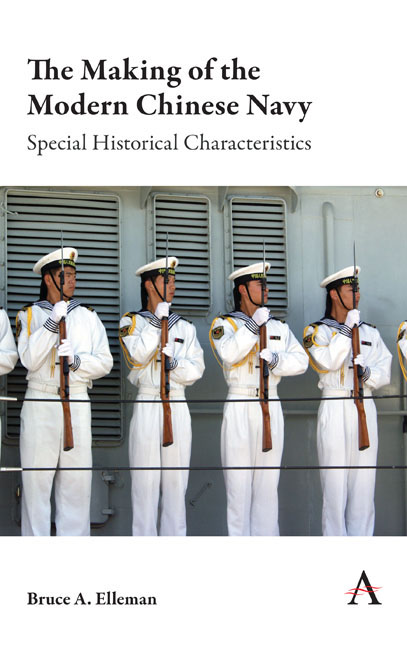Book contents
- Frontmatter
- Contents
- Introduction: The Special Characteristics of China's Maritime History
- 1 Battle of Bạch Đăng River (938)
- 2 Battle of Yaishan (1279)
- 3 Battle of Lake Poyang (1363)
- 4 Ming–Kotte War in Southeast Asia (1410–11)
- 5 Ming Loyalists Flee to Taiwan (1661–83)
- 6 Battle of Chuanbi (1839)
- 7 Sino-French War (1884–85)
- 8 Qing Beiyang Fleet's Defeat in the Battle of the Yellow Sea (1894)
- 9 Chinese Decision to Sink The Nationalist Navy as Blockships (1937)
- 10 Chongqing Mutiny Allowing the PLA to Cross the Yangzi River (1949)
- 11 The Taiwan Strait Crises (1954–55 and 1958)
- 12 China's Decision to Take the Paracel Islands from South Vietnam (1974)
- 13 Missile Blockade: The Taiwan Strait Crisis (1995–96)
- 14 The EP-3 Standoff and Diplomatic Resolution (2001)
- Conclusions: The Influence of History on the Formation of a Modern Chinese Navy
- Selected Bibliography
- Index
11 - The Taiwan Strait Crises (1954–55 and 1958)
Published online by Cambridge University Press: 04 October 2019
- Frontmatter
- Contents
- Introduction: The Special Characteristics of China's Maritime History
- 1 Battle of Bạch Đăng River (938)
- 2 Battle of Yaishan (1279)
- 3 Battle of Lake Poyang (1363)
- 4 Ming–Kotte War in Southeast Asia (1410–11)
- 5 Ming Loyalists Flee to Taiwan (1661–83)
- 6 Battle of Chuanbi (1839)
- 7 Sino-French War (1884–85)
- 8 Qing Beiyang Fleet's Defeat in the Battle of the Yellow Sea (1894)
- 9 Chinese Decision to Sink The Nationalist Navy as Blockships (1937)
- 10 Chongqing Mutiny Allowing the PLA to Cross the Yangzi River (1949)
- 11 The Taiwan Strait Crises (1954–55 and 1958)
- 12 China's Decision to Take the Paracel Islands from South Vietnam (1974)
- 13 Missile Blockade: The Taiwan Strait Crisis (1995–96)
- 14 The EP-3 Standoff and Diplomatic Resolution (2001)
- Conclusions: The Influence of History on the Formation of a Modern Chinese Navy
- Selected Bibliography
- Index
Summary
Mao Zedong responded to a 1952–53 increase in Nationalist forces along the Taiwan Strait by signing an armistice in Korea, and then moving additional troops south. The first crisis in 1954–55 led to the evacuation of the Dachen Islands, off Zhejiang province, which was Chiang Kai-shek's home province, so this was considered a personal “loss of face” for him. In 1958, the Nationalists— with help from the US Navy— resisted PLA attempts to retake Jinmen Island, blocking Xiamen harbor. In both crises, politics trumped military strategy. Mao hoped to halt the Nationalist blockade, backed up by a US strategic embargo, which was undermining China's economy. Desperate to catch up, Mao's Great Leap Forward, 1958–1961, led to one of the worst famines in history, with an estimated 45 million Chinese perishing. Meanwhile, increasing tensions with the USSR eventually resulted in a split.
Summary of the Taiwan Strait Crises
During the Nationalist retreat from the mainland in 1949, the Republic of China (ROC) on Taiwan instituted a naval blockade of the People's Republic of China (PRC). Although the Nationalist navy was comparatively large, its forces were retained mainly for defense of Taiwan's coastal perimeter. To conduct the blockade, the Nationalists worked with a number of guerrilla movements located on offshore islands not far from China's coast. Later, the US Navy helped defend Taiwan even while providing military assistance— especially aircraft— that made air patrols of the blockade possible. The Nationalist blockade of the PRC lasted from 1949 through 1958.
A Communist attack on the Nationalist-held base on Jinmen Island (Quemoy) failed during October 1949. But Communist forces, in spite of naval and air inferiority, succeeded in overwhelming the Nationalist base on Hainan Island during February–April in 1950, the Zhoushan Archipelago during May 1950, and Tatan Island as late as July 1950. By the summer of 1950, therefore, the Nationalists had lost their crucial island bases in the Bo Hai, off the mouth of the Yangzi River, and on Hainan Island. Although the Communist victories diminished the blockade area by half, the Nationalists used their remaining offshore bases to continue their blockade of the ports of Shantou, Xiamen, Fuzhou, and Wenzhou, which were critical to deter the Communists from launching an invasion of Taiwan.
- Type
- Chapter
- Information
- The Making of the Modern Chinese NavySpecial Historical Characteristics, pp. 51 - 56Publisher: Anthem PressPrint publication year: 2019



